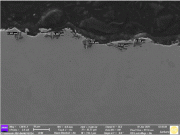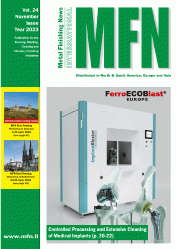E-Archive
Cover Page
in Vol. 24 - November Issue - Year 2023
Controlled Processing and Extensive Cleaning of Medical Implants

Abrasive media trapped under the surface of the implant

Implant blaster

Image of a dental implant

Image of hip implant before sandblasting and after sandblasting

Depth of abrasive media on the surface – after cleaning

Concept of implant blaster with recycling unit
The extraordinary development of medicine in all fields is fundamentally changing yesterday's "modern" approaches to the treatment and recovery of patients. In addition to new discoveries, drugs and countless possibilities to help patients, the extension of life expectancy and changed lifestyles have made Orthopaedics an extremely important branch of medicine.
Today, patients need much more interventions due to injuries or wear and tear of joints, bones, muscles, tendons and ligaments, and dental and orthopaedic prosthetics have become an indispensable aid to people. Technology and new materials and procedures have made possible an incredible range of prostheses or implants, that are increasingly inserted into the human body.
We are talking about dental and orthopaedic implants, as well as implants at the site of injuries, which today are often custom-made for the patient, practically at the clinic, which then installs the implant.
In order to minimise complications during surgery and later during recovery, it is extremely important how the implant is designed and what material it is made of, and above all, the Surface Processing And Cleanliness Of The Implant Surface before it is inserted into the human body.
The industrial production of all types of medical, orthopaedic, trauma and dental implants in the world is constantly increasing and expanding to all continents of the world. All of these implants require a prescribed surface quality for a variety of reasons. For example, trauma implants and screws must have as smooth or polished a surface as possible so that they can be removed as easily as possible after the damaged bones have healed, as a smooth surface prevents increased ingrowth of the implants into the bone or what is known as osseointegration. Whereas for implants that stay in patients forever, such as dental implants and orthopaedic implants, we want the surface of these implants to be rough because this allows for better osseous integration. The roughness of the surface is already well-researched and in most of the implant production it is mainly achieved with Controlled Sand Blasting technology. This can only be achieved with automated sandblasting procedures and controlled parameters that are adapted to both the blasting material itself and the type of implant, and of course the purpose and method of implantation in a person.
In addition to uneven or irregular roughness, the biggest risk of poor osseointegration of the implant during the sandblasting process is abrasive residues trapped on the surface and even under it. These abrasive residues appear as a foreign body and are detrimental to the implant site or surrounding tissue.
The study that we carried out at FerroECOBlast Europe, as part of a partner development and research project on a large number of dental as well as orthopaedic implants obtained from the market in 2019-2022, showed that these impurities or "trapped" abrasive covered up to 30% of the implant surface. Therefore, in addition to disinfection, a good/better or the best cleaning of the implant surface and the removal of abrasive residues is crucial for the improvement of post-traumatic conditions and unhindered osteo-integration during the recovery period and lifelong use of the implant.
Today, the surface preparation technology with sandblasting is mainly used for implants that are produced using classic technologies such as forging or casting and machining. Recently, however, implants are increasingly being produced with various 3D printing technologies, which already have a porous-rough surface, but due to the manufacturing method with laser (LPD), high-energy beam (DMLM) or sintering by Binder Jetting high temperature methods, do not have the most favourable surface structure and also require a Controlled Sand Blasting process for an ideally prepared surface.
As an abrasive for sandblasting, ultra-pure white aluminium oxide is most often used, as it has the cleanest and most neutral chemical composition. Calcium phosphate is also used as an abrasive in some places, as well as titanium oxide, but to a much less extent, mainly due to the much longer processing time and also the higher price. In the case of titanium implants, processing in an inert atmosphere of argon (Ar) or nitrogen (N) is definitely necessary.
After finishing the mechanical processing, where threads, holes and other connections important for functionality of the implant are machined, smoothing or roughening procedures follow, which are always carried out using sandblasting technology. In most cases, even today, this procedure is performed manually, where the operator holds the sandblasting nozzle and directs the jet towards the implant. In this way, processing errors are inevitable, as the quality depends largely on the competence and reliability of the operator.
Orthopaedic And Trauma Implants:
The studies and tests carried out in our company have led to the latest concept in surface treatment of implants, both dental and orthopaedic. The results of the study have been implemented in a completely new concept of automatic machines, where sandblasting is carried out in a controlled, closed-cycle process and without the influence of the operator. The operator or the robot only clamps the implant on the outside of the machine in the clamping device intended for this purpose, which also serves as a protective mask for the parts of the implant that must not be sandblasted. The first operation is sandblasting, where the robot, to which a nozzle is attached, sandblasts the implant evenly over its entire surface. The robot is crucial here, as it is the only way we can control all sandblasting parameters and follow the complex shapes of the implants. Next, two other surface cleaning processes, which are currently still in the patent-pending phase, will be integrated into our automatic machine. According to our research this year, an implant treated and cleaned in this way does not need any further chemical treatment with etching, which is still largely present today. We recommend only a short period of ultrasonic cleaning in the bath and the classic disinfection before packaging.
Dental Implants:
When sandblasting screw-shaped dental implants, the method of sandblasting and manipulation of the implants is much easier, because for a high quality and evenly polished surface, it is enough for the implant to rotate and move evenly through the abrasive jet during the sandblasting process. For sandblasting, two micro-sandblasting nozzles are used, which follow the slope of the surface of the thread and are inclined at a certain angle. This is important because both surfaces of the implant thread can be sandblasted with the same quality. During sandblasting, all movements and parameters are controlled via the PLC monitor, allowing for reproducible sandblasted implants. Of course, the used abrasive is continuously sucked out and constantly returned to the system, purified and mixed with new abrasive. It is important to know that dental implants are always sandblasted with the help of special holders and protective masks. We have also solved this process of preparation, clamping and, after sandblasting, removal of the protective rings, with the introduction of the “S/unS” automated unit, which greatly reduces the need for manual preparation of the workpieces.
Sandblasting parameters such as: distance of the nozzle from the surface, nozzle speed and, of course, the inclination of the nozzle towards the surface, which have the greatest influence on the depth of the abrasive residues in the surface, have the greatest influence on a uniformly rough surface and the depth of abrasive residues. If the inclination of the nozzle is not optimal, the abrasive will be forced deeper into the surface and it will be more difficult to remove it later, if at all.
Another key factor is choosing the right type and granularity of the abrasive. When the abrasive hits the surface, it breaks up and wears away, so it can no longer provide a consistent rough surface. For this purpose, we have installed a recycling system in our machine, which removes the worn abrasive and all crushed particles. Only abrasive suitable for sandblasting is returned to circulation and used for sandblasting needs. We have ensured this with a specially developed and patented pneumatic separator and an added abrasive sieve through a precisely defined mesh, built into an ordinary or ultrasonic vibro screen.
After sandblasting is completed, the surface is cleaned, which in current production is mostly done by etching and then by ultrasonic washing, and with a combination of these two technologies, an attempt is made to remove as much abrasive residues from the surface as possible. Etching is carried out in concentrated hydrochloric acid, but according to our latest research, it doesn’t remove any abrasive.
In our project development, we approached this problem differently. Immediately after sandblasting, we cleaned the surface of the implant with dry compressed air and next with an innovative technology, which is in the patent phase, and then cleaned it with dry ice and dry snow under high pressure - dry ice cleaning. We chose dry ice because it is made of liquid carbon dioxide (Liquid CO2) and is clean as a means of removing abrasives, as it contains no other particles or impurities that would further contaminate the surface. At the same time, dry ice crystals also have a certain mass, which upon contact with the surface creates micro-explosions and enables further removal of abrasive particles.
With the combination of advanced technologies that we used in the project, we finally achieved a very good result, as the depth of the abrasive residue was reduced from the original 30 µm to 10 µm. The proportion of the surface with abrasive residues has decreased from 23% to only 15%, which represents a 43% improvement in our surface compared with implants currently available on the market.
Conclusion:
With the combination of advanced technologies that we used and combined in the EU project IMPLANTBLASTER, we finally got a very good results:
- The depth of the abrasive residue was reduced from the original 30 µm to the 10 µm in depth
- The proportion of the surface with abrasive residues has decreased from 23% to only 15% with our system, which represents a 43% improvement in surface quality, compared with implants currently available on the market.
For Information: FerroČrtalič d.o.o.
Sela pri Dolenjskih Toplicah 47
SI-8350 Dolenjske Toplice, Slovenia
Tel. +386.7.38 45 100
E-mail: aljaz.molek@ferrocrtalic.com



























